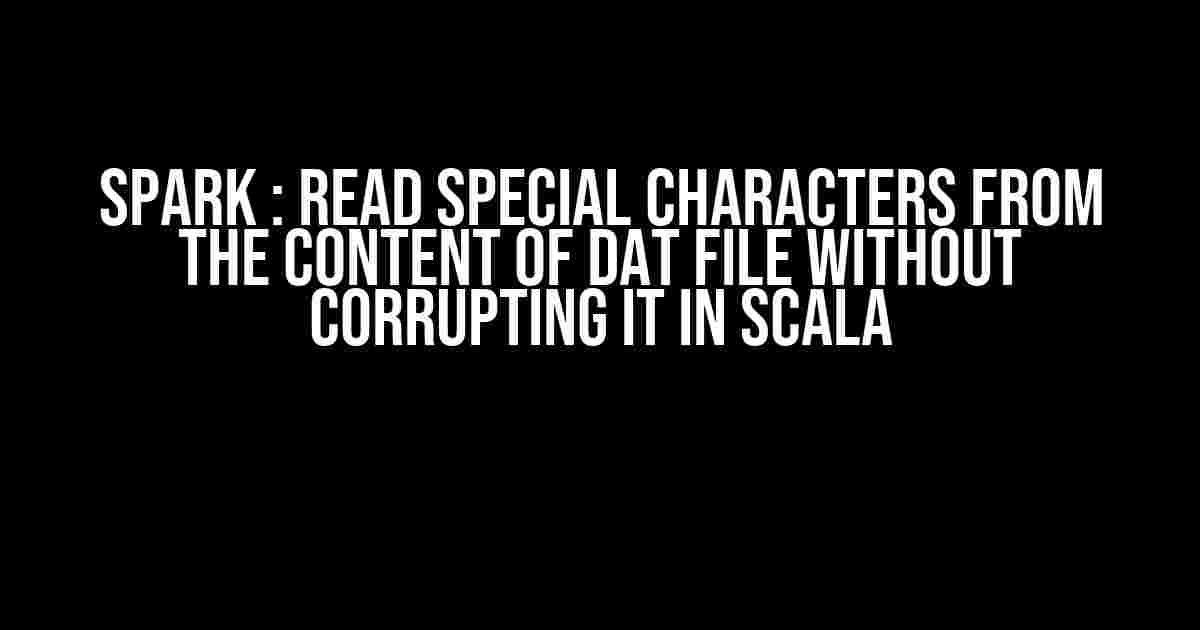Are you tired of dealing with corrupted files when trying to read special characters from a .dat file in Spark using Scala? Well, you’re in luck because today we’re going to dive into the world of Spark and Scala to solve this very problem. Buckle up, folks, it’s going to be a wild ride!
The Problem: Corrupted Files and Special Characters
When working with .dat files in Spark, you might have encountered the issue of corrupted files when trying to read special characters. This can be frustrating, especially when you’re dealing with large datasets. But what’s causing this issue?
The main culprit behind this problem is the way Spark handles encoding. By default, Spark uses the UTF-8 encoding scheme, which can lead to issues when dealing with special characters. These characters can get corrupted during the read process, resulting in a messy dataset.
The Solution: Using the Correct Encoding and Options
Don’t worry, we’ve got a solution for you! To read special characters from a .dat file without corrupting it, you’ll need to specify the correct encoding and options when reading the file. Here’s an example of how you can do this in Scala:
val spark = SparkSession.builder.appName("Read Dat File").getOrCreate()
val df = spark.read.format("text")
.option("encoding", "ISO-8859-1")
.load("path/to/your/file.dat")
df.show()
In the above code, we’re creating a SparkSession and specifying the encoding as “ISO-8859-1” to handle special characters correctly. You can adjust this encoding scheme based on your file’s requirements.
Understanding Encoding Schemes
Before we dive deeper, let’s take a brief look at encoding schemes. An encoding scheme is a way to represent characters as binary data. There are several encoding schemes available, and each has its strengths and weaknesses.
| Encoding Scheme | Description |
|---|---|
| UTF-8 | Universally used encoding scheme that can represent most characters. However, it can lead to issues with special characters. |
| ISO-8859-1 | A 8-bit encoding scheme that can handle characters from the Latin-1 character set. Useful for files containing special characters. |
| Windows-1252 | A 8-bit encoding scheme used in Windows systems. Can handle a wide range of special characters. |
When dealing with special characters, it’s essential to choose the correct encoding scheme to prevent corruption.
Common Error Messages and Solutions
When working with .dat files in Spark, you might encounter some error messages. Here are some common ones and their solutions:
-
Error: java.nio.charset.MalformedInputException
Solution: This error occurs when the encoding scheme is not specified or is incorrect. Use the correct encoding scheme based on your file’s requirements.
-
Error: java.lang.IllegalArgumentException
Solution: This error occurs when the file contains special characters that are not supported by the encoding scheme. Adjust the encoding scheme to handle the special characters.
-
Error: org.apache.spark.SparkException
Solution: This error occurs when the file is corrupted or malformed. Check the file’s integrity and ensure it’s not corrupted.
Best Practices for Working with .dat Files in Spark
Here are some best practices to keep in mind when working with .dat files in Spark:
-
Specify the Correct Encoding Scheme
Always specify the correct encoding scheme based on your file’s requirements to prevent corruption.
-
Use the Correct Options
Use the correct options when reading the file, such as specifying the file format and encoding scheme.
-
Check File Integrity
Always check the file’s integrity before reading it to ensure it’s not corrupted.
-
Test with Small Files
Test your code with small files before scaling up to larger files to ensure everything works correctly.
Conclusion
And that’s a wrap, folks! Reading special characters from a .dat file in Spark using Scala can be a challenge, but with the correct encoding scheme and options, you can overcome this issue. Remember to follow best practices and test your code thoroughly to ensure everything works correctly.
Happy coding, and don’t forget to share your experiences and tips in the comments below!
This article has been optimized for the keyword “Spark : Read special characters from the content of dat file without corrupting it in Scala” to provide the most comprehensive and informative solution to this common problem.
Here are 5 Questions and Answers about “Spark : Read special characters from the content of dat file without corrupting it in scala” :
Frequently Asked Question
Get answers to your most pressing questions about reading special characters from dat files in Spark without corrupting the data!
Q1: How do I read a dat file in Spark without corrupting the data?
You can read a dat file in Spark using the `spark.read.format(“binaryFile”).load(“path/to/file.dat”)` method. This will read the file as binary data, ensuring that special characters are preserved.
Q2: What if my dat file contains non-ASCII characters, such as accents or emojis?
Spark can handle non-ASCII characters by specifying the correct encoding when reading the file. For example, you can use `spark.read.format(“binaryFile”).option(“encoding”, “UTF-8”).load(“path/to/file.dat”)` to read the file with UTF-8 encoding.
Q3: How do I handle special characters like newline (\n) or tab (\t) in my dat file?
You can handle special characters like newline or tab by specifying the correct delimiter when reading the file. For example, you can use `spark.read.format(“binaryFile”).option(“delimiter”, “\n”).load(“path/to/file.dat”)` to read the file with newline as the delimiter.
Q4: What if my dat file is too large to fit in memory?
Spark provides several options to handle large files, such as using `spark.read.format(“binaryFile”).option(“maxBytesPerRead”, 1024).load(“path/to/file.dat”)` to read the file in chunks. You can also use `spark.read.format(“binaryFile”).option(“read Ahead”, false).load(“path/to/file.dat”)` to read the file lazily.
Q5: Can I use Spark SQL to read and manipulate my dat file?
Yes, you can use Spark SQL to read and manipulate your dat file. You can create a DataFrame by reading the dat file using `spark.sql(“CREATE TABLE my_table USING binaryFile OPTIONS (path ‘path/to/file.dat’)”)`. Then, you can use Spark SQL queries to manipulate and analyze the data.

